

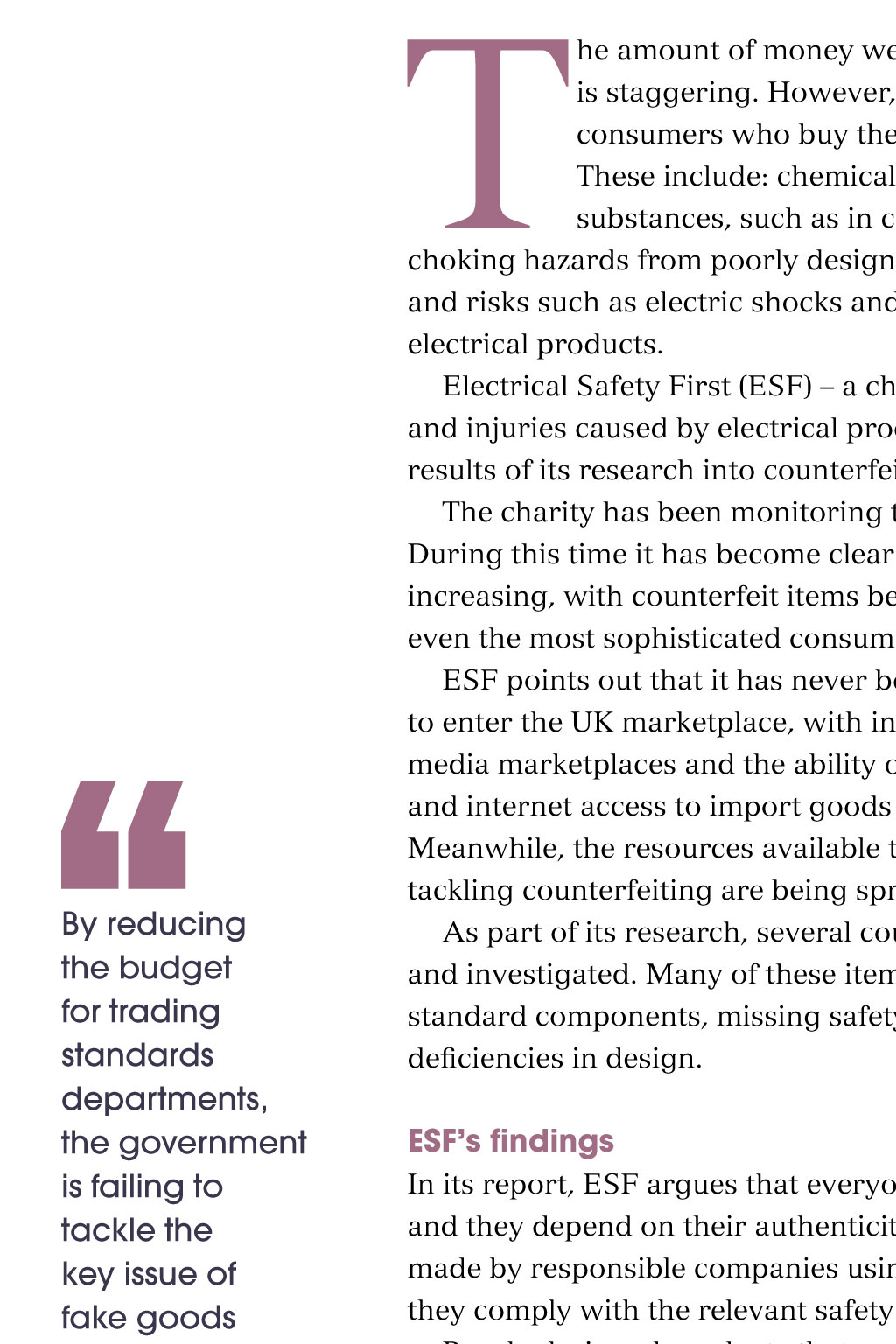
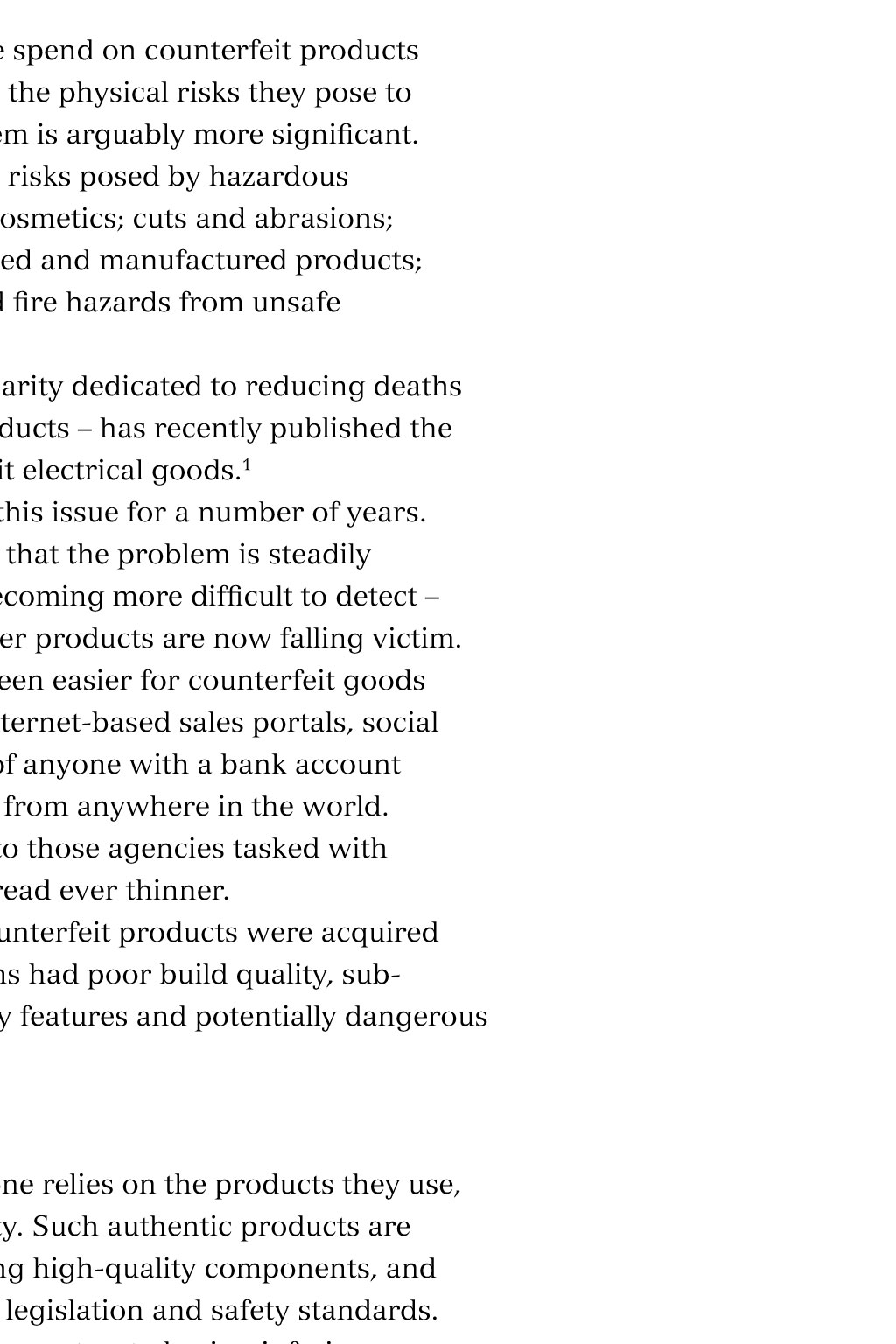
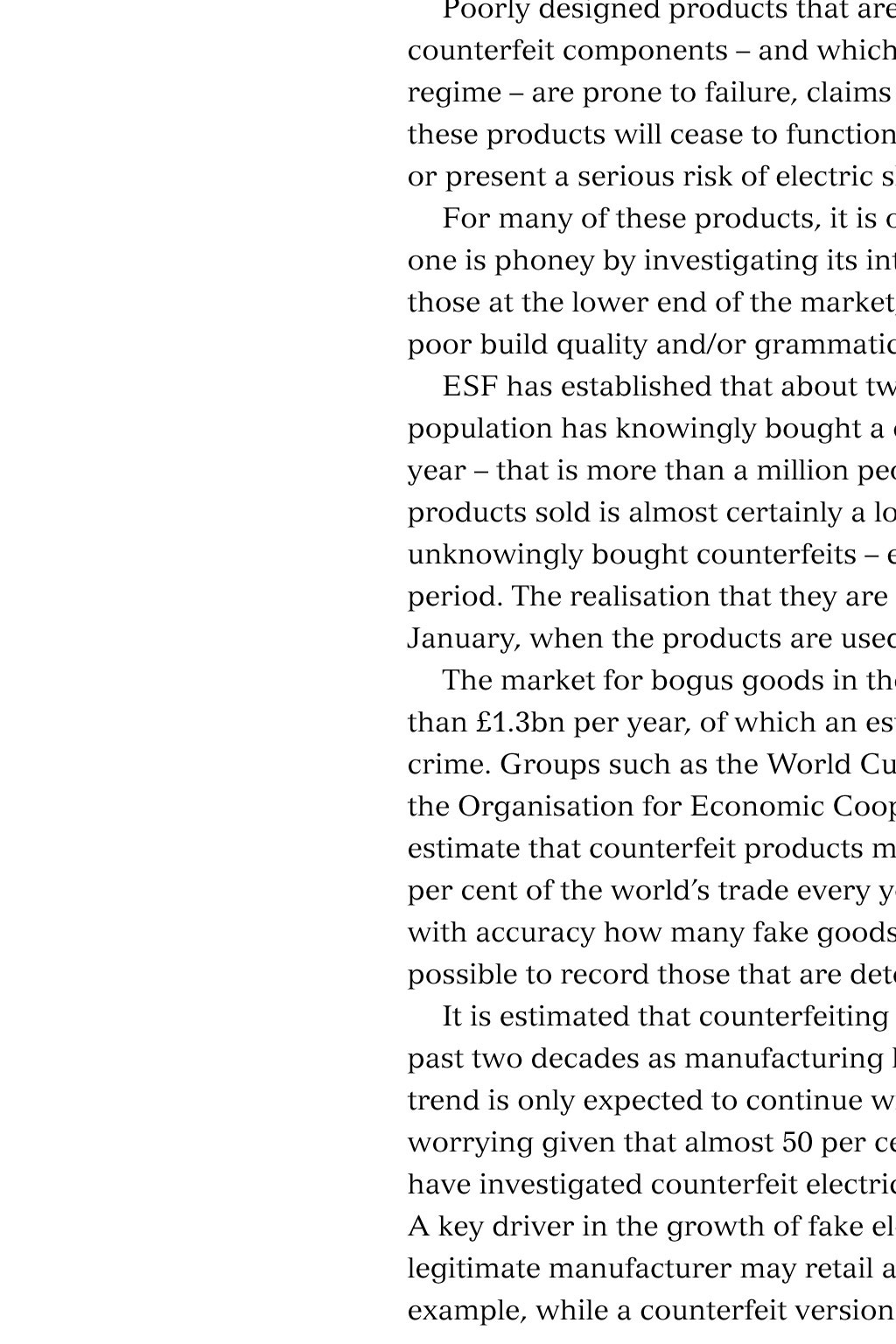
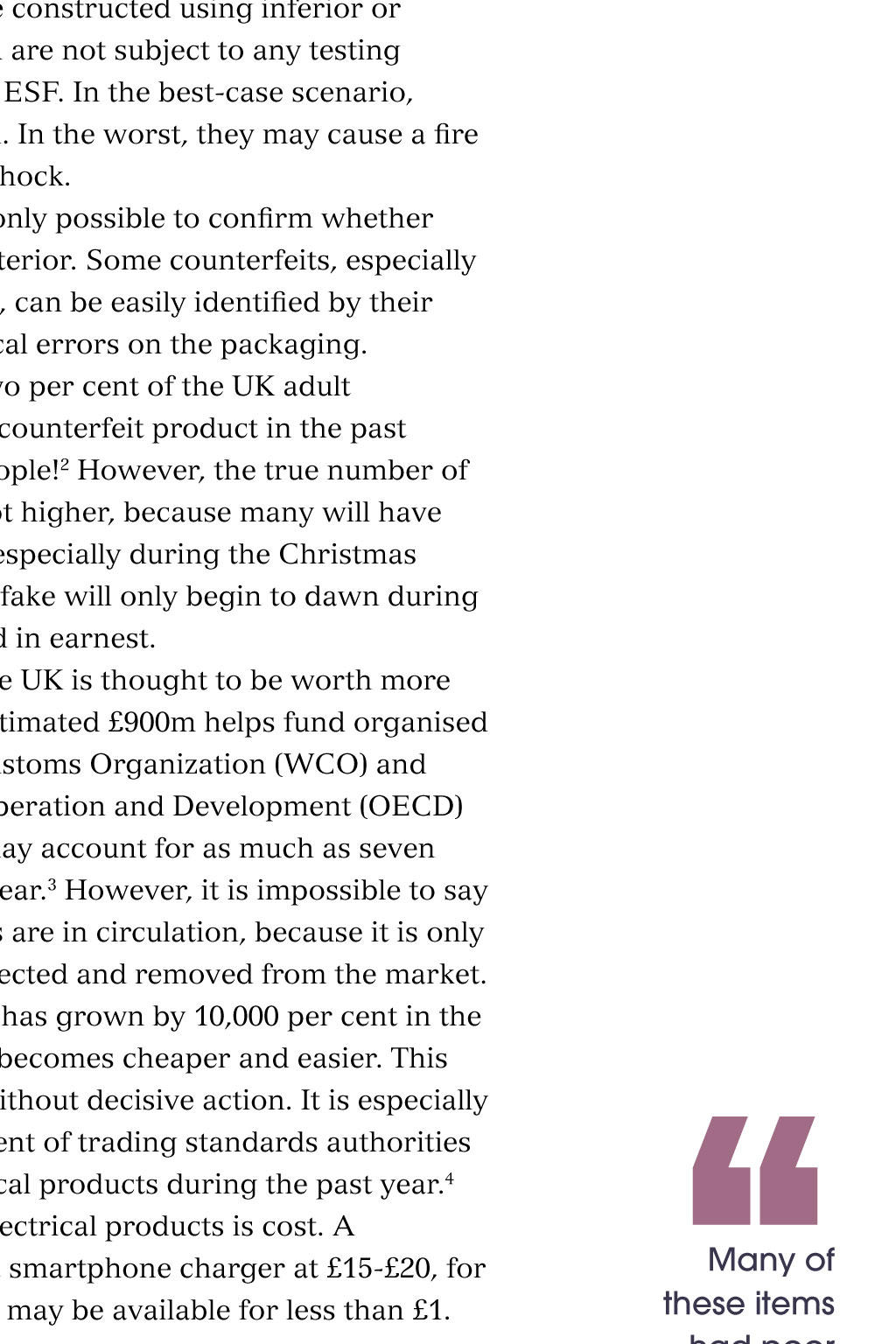
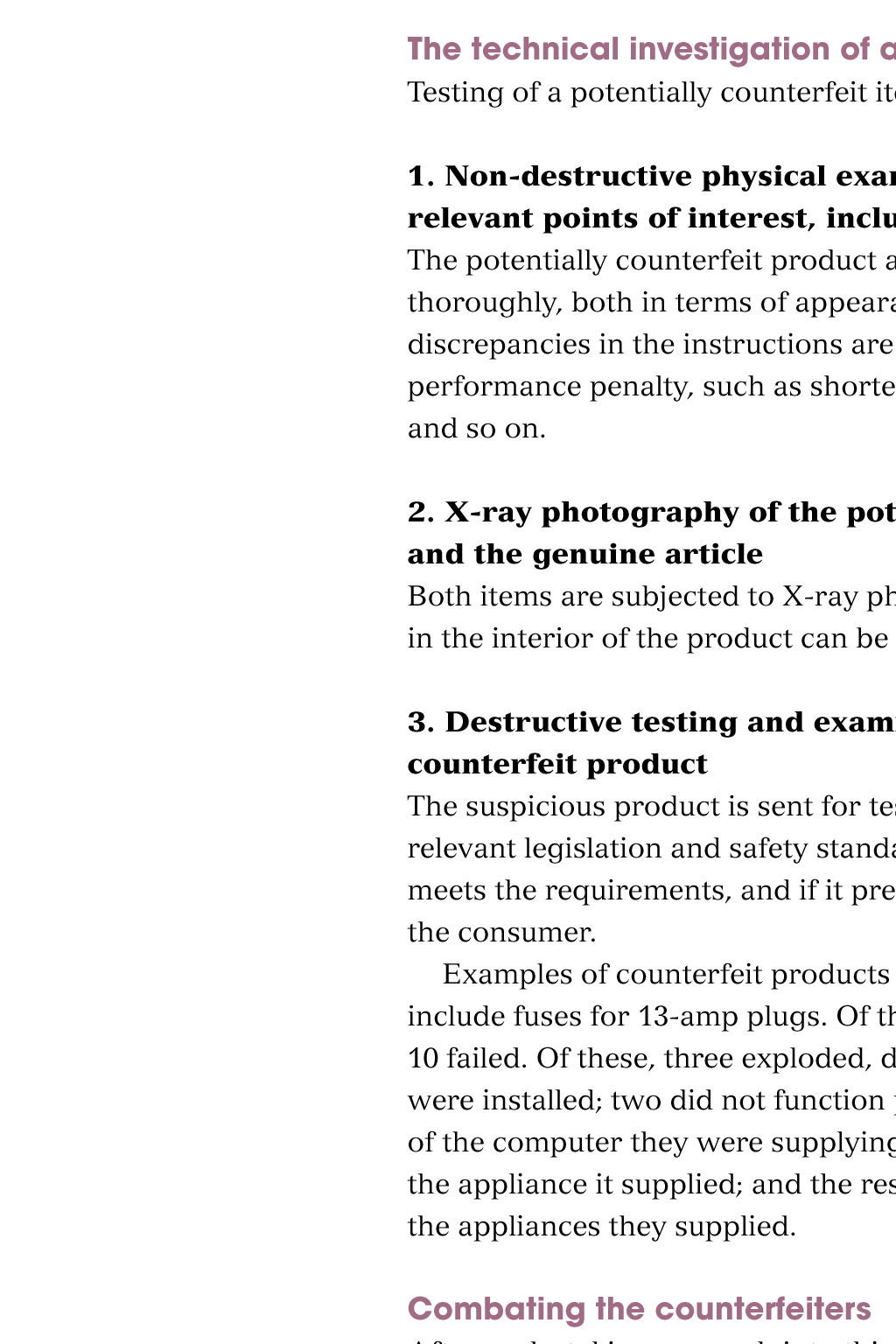

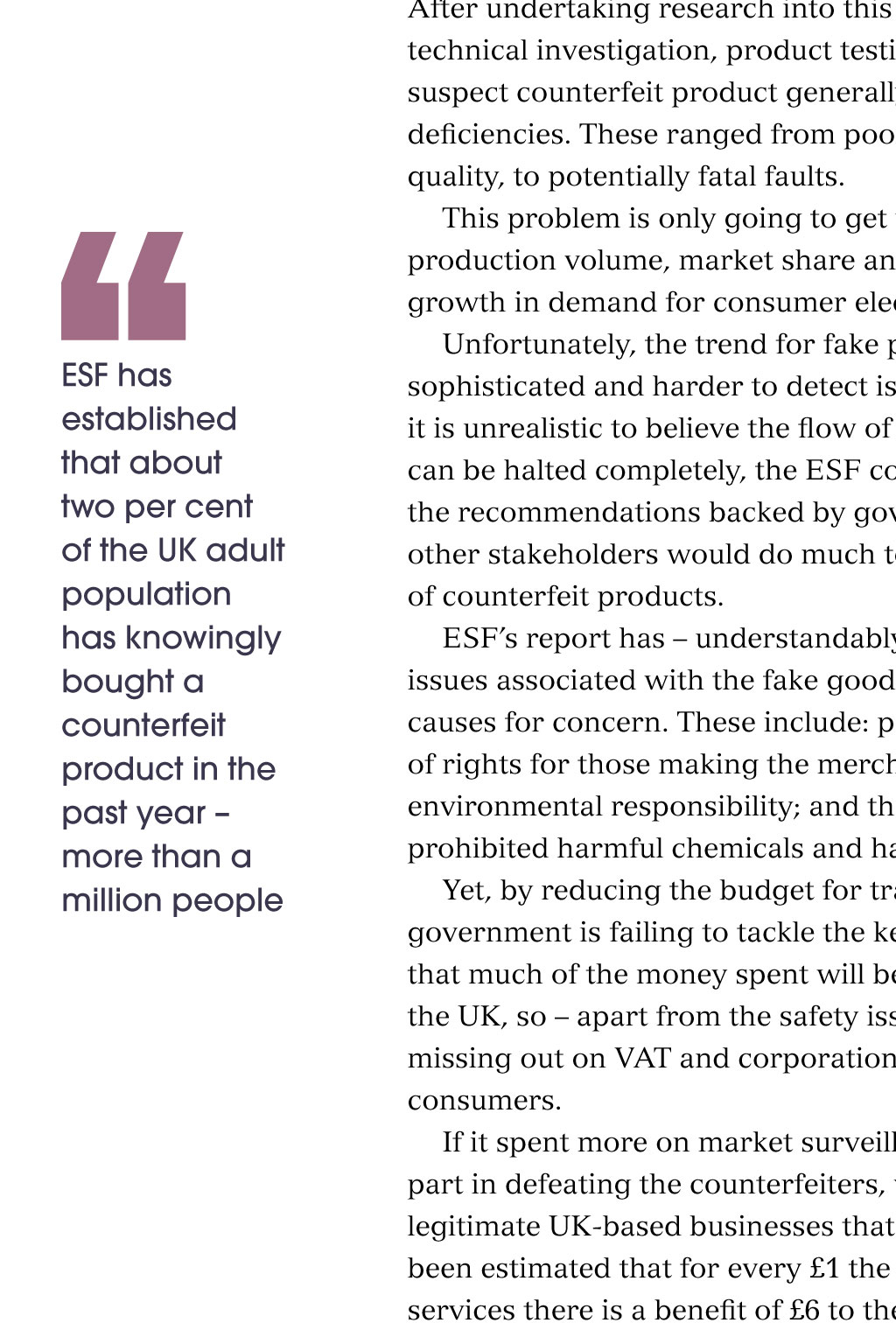
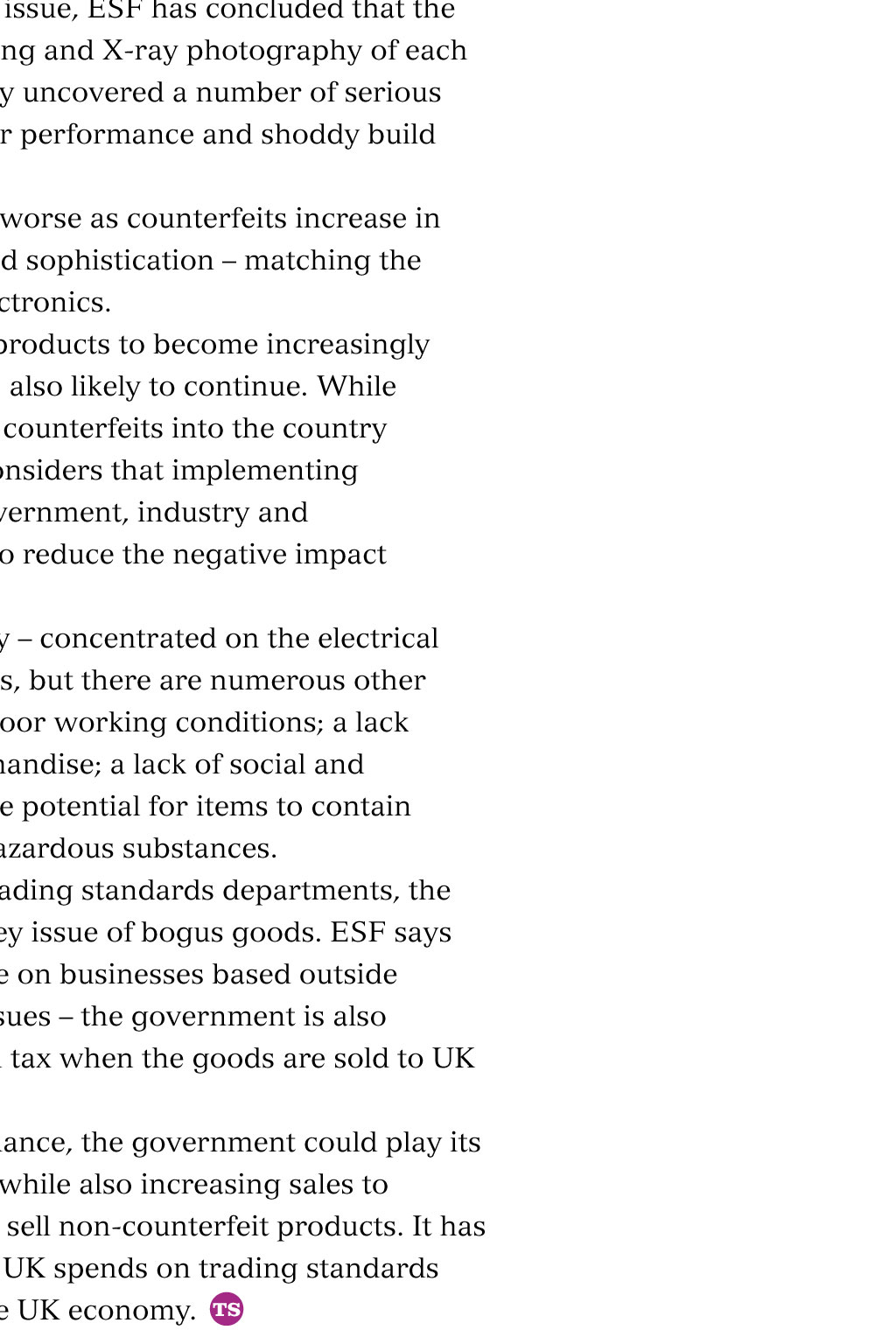
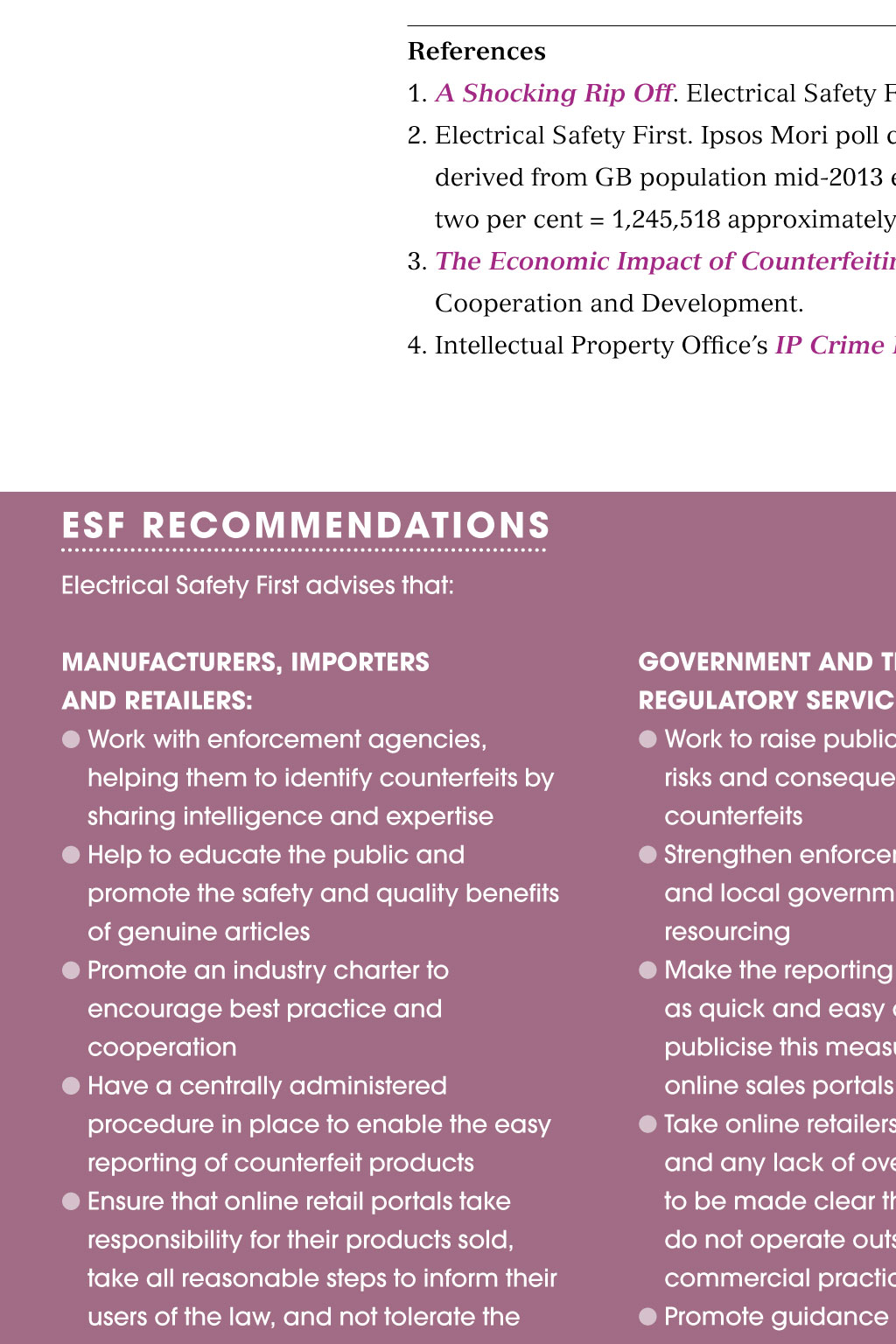
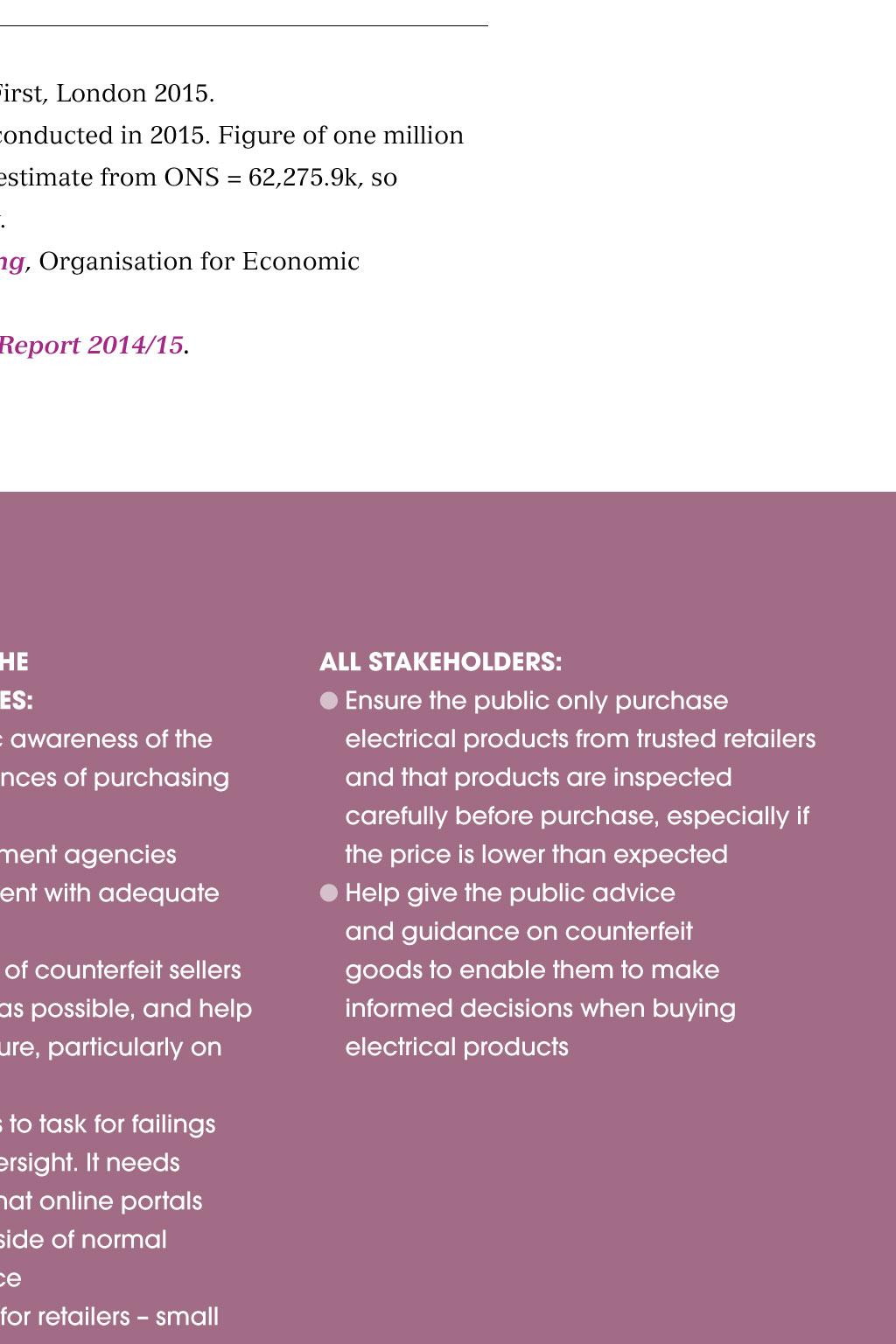

















ESF recommendations Electrical Safety First advises that: Manufacturers, importers and retailers: l Work with enforcement agencies, helping them to identify counterfeits by sharing intelligence and expertise l Help to educate the public and promote the safety and quality benefits of genuine articles l Promote an industry charter to encourage best practice and cooperation l Have a centrally administered procedure in place to enable the easy reporting of counterfeit products l Ensure that online retail portals take responsibility for their products sold, take all reasonable steps to inform their users of the law, and not tolerate the listing of counterfeits government and the regulatory se rvices : l Work to raise public awareness of the risks and consequences of purchasing counterfeits l Strengthen enforcement agencies and local government with adequate resourcing l Make the reporting of counterfeit sellers as quick and easy as possible, and help publicise this measure, particularly on online sales portals l Take online retailers to task for failings and any lack of oversight. It needs to be made clear that online portals do not operate outside of normal commercial practice l Promote guidance for retailers – small and medium-size enterprises, micro businesses and sole traders all stakeholders: l Ensure the public only purchase electrical products from trusted retailers and that products are inspected carefully before purchase, especially if the price is lower than expected l Help give the public advice and guidance on counterfeit goods to enable them to make informed decisions when buying electrical products Credits Robert Chantry-Price is a lead officer for consumer and product safety Images: © FeedStock / Alamy Stock Photo To share this page, click on in the toolbar You might also like Shock of the old – April 2015 Counterfeit products In this feature l exploding fuses l ESF l recommendations ESF has established that about two per cent of the UK adult population has knowingly bought a counterfeit product in the past year – more than a million people The amount of money we spend on counterfeit products is staggering. However, the physical risks they pose to consumers who buy them is arguably more significant. These include: chemical risks posed by hazardous substances, such as in cosmetics; cuts and abrasions; choking hazards from poorly designed and manufactured products; and risks such as electric shocks and fire hazards from unsafe electrical products. Electrical Safety First (ESF) – a charity dedicated to reducing deaths and injuries caused by electrical products – has recently published the results of its research into counterfeit electrical goods.1 The charity has been monitoring this issue for a number of years. During this time it has become clear that the problem is steadily increasing, with counterfeit items becoming more difficult to detect – even the most sophisticated consumer products are now falling victim. ESF points out that it has never been easier for counterfeit goods to enter the UK marketplace, with internet-based sales portals, social media marketplaces and the ability of anyone with a bank account and internet access to import goods from anywhere in the world. Meanwhile, the resources available to those agencies tasked with tackling counterfeiting are being spread ever thinner. As part of its research, several counterfeit products were acquired and investigated. Many of these items had poor build quality, substandard components, missing safety features and potentially dangerous deficiencies in design. ESF’s findings In its report, ESF argues that everyone relies on the products they use, and they depend on their authenticity. Such authentic products are made by responsible companies using high-quality components, and they comply with the relevant safety legislation and safety standards. Poorly designed products that are constructed using inferior or counterfeit components – and which are not subject to any testing regime – are prone to failure, claims ESF. In the best-case scenario, these products will cease to function. In the worst, they may cause a fire or present a serious risk of electric shock. For many of these products, it is only possible to confirm whether one is phoney by investigating its interior. Some counterfeits, especially those at the lower end of the market, can be easily identified by their poor build quality and/or grammatical errors on the packaging. ESF has established that about two per cent of the UK adult population has knowingly bought a counterfeit product in the past year – that is more than a million people!2 However, the true number of products sold is almost certainly a lot higher, because many will have unknowingly bought counterfeits – especially during the Christmas period. The realisation that they are fake will only begin to dawn during January, when the products are used in earnest. The market for bogus goods in the UK is thought to be worth more than £1.3bn per year, of which an estimated £900m helps fund organised crime. Groups such as the World Customs Organization (WCO) and the Organisation for Economic Cooperation and Development (OECD) estimate that counterfeit products may account for as much as seven per cent of the world’s trade every year.3 However, it is impossible to say with accuracy how many fake goods are in circulation, because it is only possible to record those that are detected and removed from the market. It is estimated that counterfeiting has grown by 10,000 per cent in the past two decades as manufacturing becomes cheaper and easier. This trend is only expected to continue without decisive action. It is especially worrying given that almost 50 per cent of trading standards authorities have investigated counterfeit electrical products during the past year.4 A key driver in the growth of fake electrical products is cost. A legitimate manufacturer may retail a smartphone charger at £15-£20, for example, while a counterfeit version may be available for less than £1. The technical investigation of a counterfeit product Testing of a potentially counterfeit item is undertaken in three stages: 1. Non-destructive physical examination and photography of relevant points of interest, including product markings The potentially counterfeit product and a genuine product are compared thoroughly, both in terms of appearance and in operation. Any discrepancies in the instructions are noted, particularly if there is a performance penalty, such as shorter operation time, slower operation and so on. 2. X-ray photography of the potentially counterfeit product and the genuine article Both items are subjected to X-ray photography, so that any differences in the interior of the product can be shown clearly. 3. Destructive testing and examination of the potentially counterfeit product The suspicious product is sent for testing in accordance with the relevant legislation and safety standard(s) to establish whether it meets the requirements, and if it presents any serious hazard(s) to the consumer. Examples of counterfeit products quoted by ESF in its report include fuses for 13-amp plugs. Of the 15 counterfeit 13A fuses tested, 10 failed. Of these, three exploded, destroying the plug in which they were installed; two did not function properly and caused the destruction of the computer they were supplying; one caused sparks to emit from the appliance it supplied; and the rest either did not operate or damaged the appliances they supplied. Combating the counterfeiters After undertaking research into this issue, ESF has concluded that the technical investigation, product testing and X-ray photography of each suspect counterfeit product generally uncovered a number of serious deficiencies. These ranged from poor performance and shoddy build quality, to potentially fatal faults. This problem is only going to get worse as counterfeits increase in production volume, market share and sophistication – matching the growth in demand for consumer electronics. Unfortunately, the trend for fake products to become increasingly sophisticated and harder to detect is also likely to continue. While it is unrealistic to believe the flow of counterfeits into the country can be halted completely, the ESF considers that implementing the recommendations backed by government, industry and other stakeholders would do much to reduce the negative impact of counterfeit products. ESF’s report has – understandably – concentrated on the electrical issues associated with the fake goods, but there are numerous other causes for concern. These include: poor working conditions; a lack of rights for those making the merchandise; a lack of social and environmental responsibility; and the potential for items to contain prohibited harmful chemicals and hazardous substances. Yet, by reducing the budget for trading standards departments, the government is failing to tackle the key issue of bogus goods. ESF says that much of the money spent will be on businesses based outside the UK, so – apart from the safety issues – the government is also missing out on VAT and corporation tax when the goods are sold to UK consumers. If it spent more on market surveillance, the government could play its part in defeating the counterfeiters, while also increasing sales to legitimate UK-based businesses that sell non-counterfeit products. It has been estimated that for every £1 the UK spends on trading standards services there is a benefit of £6 to the UK economy. References 1. A Shocking Rip Off. Electrical Safety First, London 2015. 2. Electrical Safety First. Ipsos Mori poll conducted in 2015. Figure of one million derived from GB population mid-2013 estimate from ONS = 62,275.9k, so two per cent = 1,245,518 approximately. 3. The Economic Impact of Counterfeiting, Organisation for Economic Cooperation and Development. 4. Intellectual Property Office’s IP Crime Report 2014/15. Fake products are not only dangerous, but they cost the UK consumer more than £1.3bn per year. Robert Chantry-Price looks at the findings of an Electrical Safety First investigation into unsafe goods Fake, rattle and explode Many of these items had poor build quality, sub-standard components, missing safety features and potentially dangerous deficiencies in design By reducing the budget for trading standards departments, the government is failing to tackle the key issue of fake goods.